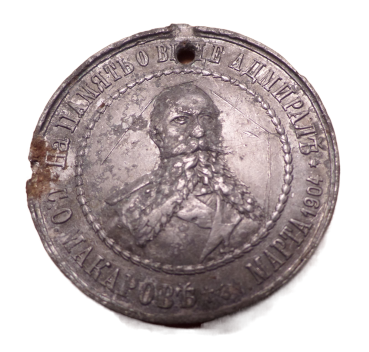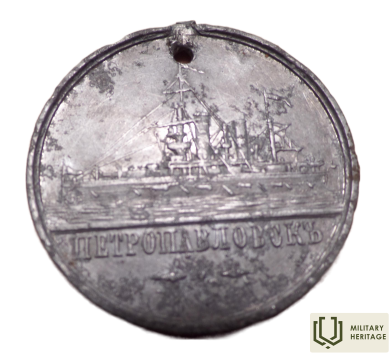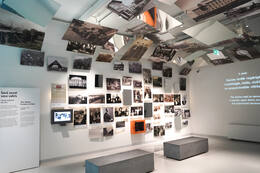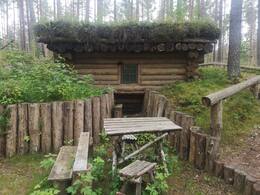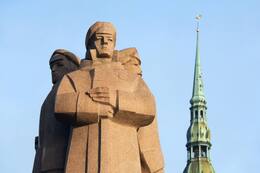Kieme rastas admirolui Makarovui skirtas atminimo ženklelis.
Mažas karinis reliktas gali papasakoti didžiulę istorinę istoriją. Ir nors ženklelis simbolizuoja įvykius, vykusius Rusijos-Japonijos karo metu, jis taip pat atskleidžia spalvingą karinę istoriją ir mūsų Latvijos šaulių dalyvavimą kituose kariniuose konfliktuose tiek prieš Nepriklausomybės karus, tiek po jų.
Ženklelis buvo rastas Vidrižių valsčiuje, prie tvarto pamatų. Tai atminimo ženklas, skirtas admirolui Makarovui. Jis dalyvavo jūrų atakose Rusijos-Turkijos ir Rusijos-Japonijos karuose. 1904 m. (Rusijos-Japonijos kare) jo laivas „Petropavlovskas“ užvažiavo ant minos ir jis žuvo. Markovas buvo viena iš pagrindinių Rusijos karinio jūrų laivyno ir laivyno figūrų. „Petropavlovsko“ nuskandinimas buvo smūgis laivynui su toli siekiančiomis pasekmėmis. Rusija skaudžiai pralaimėjo karą su Japonija, o tai išryškino jos padėtį kitame išsivystymo lygyje. Tai nebuvo vienintelis laivas, sunaikintas jūrų mūšyje ar užvažiavęs ant minų. Greičiausiai jį į Latviją atgabeno Latvijos jūreivis, tuo metu tarnavęs kariniame jūrų laivyne. Rusijos-Japonijos karas – tai karas, kai latviai masiškai stojo į Rusijos armiją, daugiausia sausumos pajėgose.
Dabartinio žemvaldžio vertinimais, žetono savininkas ir netekėjas galėtų būti buvęs žemvaldis, kuris grįžęs iš Rusijos Tolimųjų Rytų karo taip pat dalyvavo Latvijos laisvės kovose ir kaip Latvijos šaulys gavo šią žemę Vidrižuose. Aliuminio žetonas gerai išsilaikęs žemėje, jo skersmuo yra 3,5 cm. Jame taip pat yra skylė, greičiausiai skirta žetonui pakabinti ant kaklo ar kitaip pritvirtinti.
Susijusi laiko juosta
Susijusios temos
Susijusios vietos
Latvijos okupacijos muziejus
Muziejuje eksponuojama Latvijos istorija nuo 1940 iki 1991 m., nacistinės Vokietijos ir Sovietų Sąjungos okupacijos laikotarpiu. „Ateities namai“ – tai žinomo Amerikos latvių architekto Gunāro Birkertaus suprojektuoto Okupacijos muziejaus rekonstrukcijos ir išplėtimo projektas, taip pat nauja muziejaus ekspozicija. Ekspoziciją „Čekos istorija Latvijoje“ sukūrė Okupacijos muziejus, ji yra buvusiame SSRS Valstybės saugumo komiteto (KGB) pastate „Kampiniame name“. Latvijos okupacijos muziejus buvo įkurtas 1993 m. Jis pasakoja ilgai slėptą Latvijos valstybės, tautos ir žemės likimo istoriją dviejų užsienio totalitarinių valstybių okupacijos laikotarpiu nuo 1940 iki 1991 m. 2020 m. pabaigoje muziejuje buvo daugiau nei 70 000 įvairių istorinių eksponatų (dokumentų, nuotraukų, rašytinių, žodinių ir daiktinių įrodymų, daiktų ir atminimo dovanų). Muziejaus specialistai įrašė daugiau nei 2400 vaizdo įrašų, todėl tai viena didžiausių okupacijos kolekcijų Europoje. Latvijoje, Lietuvoje ir Estijoje klostęsi įvykiai aiškiai parodo, ką tautoms teko ištverti valdant dviem totalitariniams režimams.
Latvijos šaulių pozicijos ir apkasai Tyreliuose
Latvijos šaulių apkasai ir apkasai Tyreliuose yra Babytės valsčiuje, Mārupe savivaldybėje, netoli Antinių latvių šaulių kapinių ir buvusio vaistų sandėlio. Pirmojo pasaulinio karo metu tai buvo Rusijos imperijos armijos Latvijos šaulių gynybinė pozicija. Smėlėtose kalvose buvo įrengtas apkasų ir paviršinių apkasų kompleksas. Apkasinė arba pozicinė kova – tai geriausias būdas tiksliai apibūdinti Pirmąjį pasaulinį karą ir pabrėžti įtvirtinimų svarbą. Jie buvo pagrįsti karo inžinierių tyrimais, pritaikyti prie aplinkos ir naujų ginklų kūrimo. Kareivio kasdienybė – tai nuolatinis gynybinių įtvirtinimų tobulinimas. Kartais kareiviai apkasams duodavo pavadinimus, kurie primindavo jų namus ir padėdavo pamiršti karo realybę. Apkasų linijos buvo sudėtingos gynybos sistemos, kurias priešui buvo sunku perimti. Tobulėjant ginklams, ši gynyba tapo dar sudėtingesnė. Apkasų stogai buvo sutvirtinami, kad atlaikytų artilerijos sviedinius. Apkasai buvo kasami keičiant schemas ir kryptis, kad sprogimai padarytų kuo mažiau žalos. Judėjimo praėjimuose buvo kišenės, kurios buvo naudojamos kaip trumpalaikės slėptuvės artilerijos ugnies metu, nes jos saugojo kareivius nuo skeveldrų ir nuolaužų. Šiandien dalis įtvirtinimų yra atkurta, ir galite aplankyti 3 restauruotus apkasus ir 100 m ilgio apkasų atkarpą.
Latvijos šaulių paminklas Rygoje
Įsikūręs Rygos centre, Latvijos šaulių aikštėje, netoli Latvijos okupacijos muziejaus.
Latvijos šaulių paminklas buvo atidengtas 1971 m. Latvijos šaulių aikštėje, šalia buvusio Latvijos raudonųjų šaulių muziejaus (dabar Okupacijos muziejus). Sovietmečiu į šią temą buvo žiūrima per siaurą komunistinio režimo ideologinę prizmę. Ši vieta tarnavo kaip Rygos reprezentacija ir idealizuoto pasakojimo kūrimas, sustiprinant mitą apie latvius kaip kovotojus už sovietų valdžią.
Rusijos armijos lengvieji pėstininkų daliniai buvo vadinami šauliais. Pirmojo pasaulinio karo metu Latvijos šaulių junginiai buvo kuriami kovai su Vokietijos armija tėvynėje. Tai buvo motyvuoti, pavojingi ir drausmingi koviniai daliniai. Aukštas išsilavinimo lygis ir vokiečių kalbos žinios buvo naudingos žvalgybai ir netikėtų atakų vykdymui. Žlugus Rusijos imperijai ir Vokietijai visiškai okupavus Latvijos teritoriją, labai daug Latvijos gyventojų atsidūrė Rusijoje, kur toliau susidūrė su bolševikų agitacija. Iš pradžių palaikymas Lenino idėjoms ir dalyvavimas Rusijos pilietiniame kare augo. Vėliau kilo nusivylimas, ir dauguma Latvijos kareivių nusisuko nuo kairiųjų idėjų ir grįžo į Latviją. Dauguma Rusijoje likusių kareivių žuvo per „Stalino valymus“ (1936–1938 m.). Latvijos šauliai labai prisidėjo prie Latvijos valstybės ir jos kariuomenės kūrimo.
Šiandien galite aplankyti paminklą ir gretimą Okupacijos muziejų.




